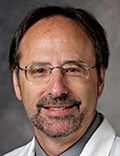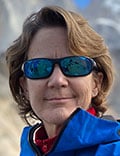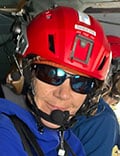A few weeks into a medical school project in Bethel, Alaska, Eric Weiss, MD, got a call in the middle of the night from Nunivak Island in the Bering Sea.

The caller, a Native American health aid with 2 weeks of first aid training, was with a Yup'ik woman whose blood pressure and pulse were nearly undetectable. She suspected the woman might be pregnant. But in Mekoryuk – the island's only village inhabited by about 200 native people — there were no pregnancy tests to be found.
Weiss climbed aboard a dual-engine Twin Otter airplane with a small medical kit. As the plane approached Nunivak, the island was invisible in the darkness. Suddenly, about 100 Mekoryuk residents emerged from their homes, holding flashlights and candles. They lined the airstrip from end to end, illuminating it so the pilot could land safely.
Weiss rushed to the sick woman and found her unconscious and borderline unresponsive. She'd been bleeding, and the pregnancy test Weiss brought confirmed she was pregnant, which seemed to indicate a ruptured ectopic pregnancy.
They got the woman aboard the Twin Otter and Weiss called the ob/gyn in Anchorage, 3 hours away. "You don't have time," the ob/gyn told him. "You're going to have to operate."
Providing care to patients with limited access to medical resources, often on a volunteer basis, is central to the field of wilderness medicine, also known as austere medicine.
And yes, things can get wild.
Medicine Stripped Down to Its Essence
The Wilderness Medicine Society was established in 1983, and the field has grown rapidly, particularly over the past two decades. This is due in part to the creation of wilderness medicine fellowships, the first of which was founded by Weiss at Stanford in 2001. It has also coincided with a growing awareness of the relationship between the environment and human health. Physicians in the field must often address health problems caused, or at least fueled by, environmental factors, such as secluded locations and harsh weather conditions.
On Nunivak Island, Weiss prepared to operate on his patient with the pilot holding a flashlight and the phone duct taped to his ear. With the ob/gyn talking him through the procedure, he found the source of the bleeding and went in with towels and clamps. The three of them then flew to Anchorage where Weiss' handiwork was cleaned up at the hospital.
The patient survived. Later, her father made his way from Nunivak Island all the way to Bethel to give Weiss a Yup'ik knife called an ulu. He had carved scrimshaw into the ulu's ivory handle with his native word for "thank you."
Weiss's rescue mission is the epitome of wilderness medicine, but not only because of the late-night, high-stakes plane ride to the permafrost-covered island in the middle of the sea. Rather, it was the deciphering of clues, the significance of simple resources, and the need to improvise.
"It's still the most amazing thing I've ever done," Weiss, now professor emeritus of emergency medicine at Stanford University, says of the experience. "It absolutely solidified my interest in practicing medicine not entirely in the cocoon of an emergency department, but in austere places where people need you the most."
"The Dirt Doctor": Into the Wild Without Support
On one of her search and rescue missions, Alison Sheets, MD, an emergency physician and medical director for Rocky Mountain Rescue Group, had to climb more than 1000 feet up a cliffside to help a woman with a fractured ankle. The altitude was not a problem for Sheets, an experienced mountaineer, former rock climbing guide, and professional ski patroller. But in her usual emergency department setting, it would have been a nurse's job to administer analgesic pain medication.

Without a nurse's understanding of timing and dilution, Sheets drew the meds out a little too fast. "Oh my God," the injured climber said. "I feel horrible and I think I'm going to die." (She was ultimately okay.)
"Wilderness medicine is very different in that you don't have all the supporting structures," Sheets says. "You don't have nurses. You don't have techs. You don't have pharmacies. You don't have good lighting. You don't have comfortable rooms and climate control. Over the 10 or 15 years I've been doing this, I've kind of thought of myself as 'the dirt doctor.'"
Sometimes Nature Wins
Weiss recalls another incident on the Chattooga River while he was a student at Emory University. His biology teacher was Claude Terry, PhD, DABT, who did the stunt canoeing for Burt Reynolds in the 1972 movie, Deliverance. The Chattooga, where the movie was filmed, is one of the longest free-flowing rivers in the United States through the Carolinas to Georgia. With limited public entry and exit points, the shortest rafting trip takes 4-6 hours.
Terry recruited Weiss and other students who were expert kayakers to help run a commercial rafting company. They found themselves frequently rescuing people from the river and providing basic medical care.
One summer day, Weiss came across a rafter who was splayed out on the rocks, confused and sweating. He had been drinking beer all day, so those in his group thought he was just drunk and dehydrated. Weiss, who had recently become a paramedic, noted the patient's symptoms and took his temperature. The number rose as high as the thermometer read, to around 108 °F. Heatstroke.
The group rafted down the river for almost 2 hours to the exit point, fanning the patient and trying to cool him with ice bags. By the time they reached the hospital, the patient's temperature had reached 110 °F. He was flown to another hospital, in Athens, Georgia.
Unadorned by contemporary conveniences, wilderness medicine relies on the crudest and most crucial healthcare components (a pregnancy test or a thermometer). But no matter the tools at hand or the adroitness of the doctor at the scene, the sheer force of nature — in this case, intense heat on a secluded river — can often overpower human capability. Weiss's patient didn't make it.
"A Fine Line Between Wilderness Medicine and Urban Medicine"
Environmental medicine is central to wilderness medicine, says Weiss. "It's not hard to see the link between global warming and human illness," he says, "and human afflictions are proliferating due to manmade environmental change, not just intense heatwaves, but flooding, air degradation, and people having more asthma attacks and spreading mosquito-borne diseases."
Wilderness medicine addresses issues that may be more commonplace in the wild, like avalanches and tick-borne diseases. But cities are just as susceptible to natural disasters, and they tend to be hotspots for infectious diseases. Urban areas are also increasingly prone to extreme temperatures and resultant conditions like heatstroke and frostbite.
"There's a fine line between wilderness medicine and urban medicine," Weiss says. "Natural and manmade disasters like the Haiti earthquake, Hurricane Katrina, and the September 11 attacks created environments as limited as wilderness in the middle of the city by destroying or damaging power, transportation, communication, and healthcare facilities. The knowledge you gain in wilderness medicine can be very useful in those environments."
Austere Medicine Is All About Access
Many physicians enter wilderness medicine to spend more time outdoors, but a major misconception about the field is that it's all action and adventure. But the guiding principle is access, not adventure.
"I think wilderness medicine is burdened by its nomenclature," says N. Stuart Harris, MD, founder and chief of the Massachusetts General Hospital Division of Wilderness Medicine and the director of its wilderness medicine fellowship. "People inject all kinds of thoughts into what wilderness medicine is, [like] you've got to be on the top of Mount Everest or something, but I see it as creating experts who can bring care to people where they are."
Speaking of Everest…
While it may not be a requirement, Harris, Sheets, and Weiss have all worked near Everest Base Camp in Nepal.
Harris went there as a third-year medical student, on a grant from a major pharmaceutical company, to study high-altitude headaches. Weiss has worked three seasons at the Himalayan Rescue Association's Everest Base Camp Clinic. Sheets describes her 3-month stretch at the Everest clinic in 2008 as "one of the more rewarding experiences" of her life.

The work on Everest involves treating common afflictions ranging from blisters to high-altitude cough and mountain sickness. Volunteers primarily care for western tourists, but they also treat local Nepalese porters and Sherpa guides who don't always have access to good medical care.
Says Weiss: "It's so rewarding to be able to share what you learned in a good health system and take it into an austere health system and apply it and throw in a twist of improvisation and creativity."
"Keep the Wilderness Wild"
In many cases, those most affected by extreme environmental conditions — like Yup'ik people on Nunivak Island and Sherpas on Mount Everest — have the least access to medical care and therefore need and appreciate it most.
Wilderness medicine should be about bringing medical care to people in need in remote areas, Sheets says, rather than bringing all the comforts and conveniences of the developed world to tourists on outdoor adventures. She's concerned about what she refers to as "the medicalization of the wilderness."
"I fully want people to go in the backcountry and experience the joy and the beauty and the nature, in the hopes that they'll want to support nature and support the environment," Sheets says, "but I see people going into the backcountry and expecting the full support of modern society if they mess up. They want a helicopter right now, and they expect immediate ICU care to be plunked down wherever they are. I want to see us keep the wilderness wild."
Wilderness doctors experience firsthand how caring for humans and caring for the environment are one and the same — which is why Harris aims to have the medical field recognize health as an "ecological phenomena."
"Healthcare isn't an architectural phenomena," he says. "People think of health as something that happens in hospital walls, [but] the sole generator of our health is a functioning biosphere. If we threaten that, if that environment is being fundamentally altered, there should really be no greater sense of urgency for a physician."


Comments